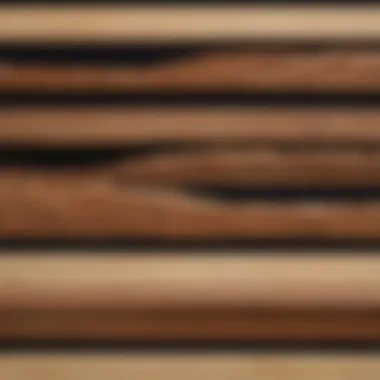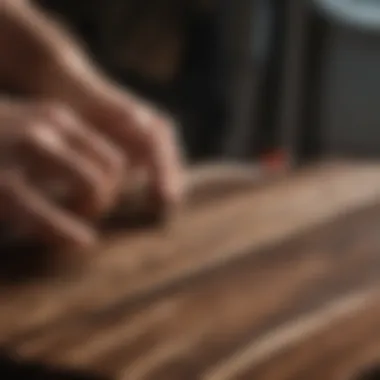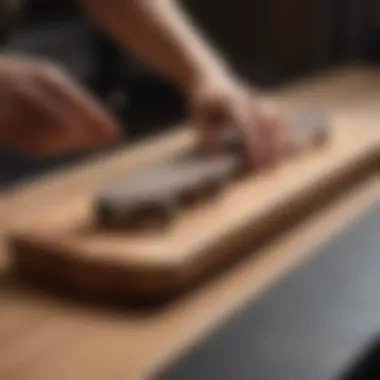Exploring Wood's Role in Crafting High-Performance Fingerboards


Intro
The crafting of fingerboards significantly revolves around the material choices, especially wood, which is often the heart of many designs. Selecting the right wood can dictate factors like durability, performance, and overall user experience. As the sport has evolved over the years, so have the understandings of how various woods impact the fingerboarding practice. This discussion is crucial for both enthusiasts and potential crafters, allowing for informed decisions that affect both performance and enjoyment.
The History of the Sport
Origin and Evolution
Fingerboarding emerged in the late 1970s and gained popularity throughout the 1980s. Originally designed as a miniature version of skateboarding, the fingerboard developed from the simple concept of using one’s fingers to mimic skateboarding tricks. Early versions were handmade and often crafted from scrap materials, including wood or plastic. Over the years, the sport adopted more sophisticated designs, leading to a variety of shapes and materials tailored to enhance performance.
Milestones and Influences
The progression of fingerboarding has witnessed numerous milestones. The release of quality fingerboards in the 1990s marked a significant leap in the sport’s credibility, introducing professional-level equipment. Pioneering brands like Tech Deck played an influential role in shaping the market. With the rise of the internet in the early 2000s, tutorials, videos, and forums allowed enthusiasts to share techniques and innovations, further boosting its popularity.
Key Athletes and Pioneers
Several figures have been influential in popularizing fingerboarding. For instance, the emergence of competitive events and professional fingerboarders raised the sport’s profile. These athletes have contributed to refining the techniques and demonstrating what is possible with skill and the right gear. Their influence continues, inspiring new generations to explore the sport and its crafting.
Understanding the evolution helps grasp the significance of wood selection in fingerboarding today.
Techniques and Skills
Basic Techniques for Beginners
Fingerboarding requires a grasp of basic tricks and techniques. Newcomers should start with fundamental movements like ollies and kickflips. Practicing on various surfaces and ramps enhances learning. Understanding how wood type affects grip and slide is also invaluable in selecting the right board.
Advanced Skills to Acquire
As skill levels rise, practitioners should pursue more complex movements, such as grinds and slides. Mastery of these skills often involves adjusting the choice of wood to increase performance. For example, lighter woods may allow for quicker tricks, whereas denser woods can provide better stability during landings.
Common Mistakes and How to Avoid Them
Beginners frequently overlook the importance of wood quality and its effect on tricks. Selecting boards without understanding the properties of different woods can hinder progress. Practitioners should also focus on technique, ensuring that finger movements are precise, as even minor errors can lead to frustration.
Safety Measures
Essential Safety Gear
While fingerboarding generally poses lower risks compared to other sports, using safety gear can mitigate minor injuries. Recommended items include wrist guards, elbow pads, and depending on the surface, knee protection. Although not mandatory, these accessories can offer comfort and confidence.
Safety Practices and Procedures
Safety practices are foundational in any sport. Familiarizing oneself with the chosen environment is essential. One must secure ramps against any dislodging that could lead to accidents. Additionally, practicing in a controlled area reduces the chance of collisions with bystanders or obstacles.
How to Prepare for Unexpected Situations
Willingness to adapt is crucial. Unforeseen circumstances, like sudden obstacles or environmental changes, require attentiveness. Keeping a clear mind and ensuring a space free of distractions can be pivotal in avoiding injuries.
Gear Recommendations
Top Brands and Products
Several brands dominate the fingerboard landscape. For durable and well-crafted options, consider Blackriver Ramp, Flatface, and Tech Deck. Each brand offers unique designs tailored to different skill levels and preferences.
Budget vs.
Premium Options
Budget options are available but may not offer the same performance as premium products. For a medium price range, brands like Flatface provide quality without being overly expensive, while high-end boards from Blackriver ensure long-lasting durability.
Maintenance and Care for Gear
Proper maintenance preserves the integrity of fingerboards. It is essential to clean the wood surface regularly to prevent dirt buildup, which can affect grip. Additionally, checking for signs of wear, especially on the ramps and wheels, helps ensure a safe and enjoyable experience.
Understanding the various aspects of wood in fingerboarding deepens appreciation for the sport. Material choices play a prominent role, influencing not just performance but the very essence of fingerboarding culture.
Prologue to Fingerboarding
Fingerboarding, often seen as a niche activity, is a fascinating intersection of skill and creativity. This section explores its importance, providing a foundation for understanding the nuances of fingerboard crafting.
The significance of fingerboarding goes beyond mere entertainment. It combines elements of skateboarding with miniature replicas, allowing enthusiasts to engage in complex tricks and maneuvers on a smaller scale. This unique form of expression has attracted a diverse community of practitioners who appreciate the craftsmanship and performance aspects of fingerboards.


Key Benefits of Understanding Fingerboarding
- Enhances appreciation for the craft of fingerboard production.
- Highlights the role of materials, particularly wood, in performance.
- Informs purchasing decisions for enthusiasts and crafters.
Furthermore, fingerboarding serves as a medium for creativity. It allows users to customize their boards, honing their design aesthetics while simultaneously testing their skills.
As we delve deeper into fingerboarding, we will discuss its definition and its evolution over the years, shedding light on how it has developed from a pastime to a complex craft. This exploration of fundamentals sets the stage for understanding the crucial role of wood in fingerboard crafting.
What is Fingerboarding?
Fingerboarding is the art of using one’s fingers to maneuver a small skateboard-like object over various surfaces. It often mimics the tricks performed on full-sized skateboards, such as ollies, kickflips, and grinds. With the aid of fingerboards, users can engage in a highly technical and physical expression of creativity.
These tiny boards are typically crafted from wood or advanced composite materials. The sport has seen mainstream popularity, influenced by skateboarding culture, yet it retains a distinct identity. Fingerboarders often showcase their skills in online videos, fostering a community that thrives on competition and collaboration.
Origin and Evolution of Fingerboarding
Fingerboarding originated in the 1970s as a way for skateboarders to practice tricks indoors. It started with homemade wooden models, often crafted from repurposed materials. The early fingerboards were rudimentary, primarily serving as a tool for practicing skateboarding techniques during unfavorable weather.
As the years progressed, interest in fingerboarding grew. In the 1990s, commercial fingerboards made their entrance, capturing the attention of children and adults alike. Brands like Tech Deck popularized the activity by offering affordable, customizable boards that closely resembled their larger counterparts.
The evolution of technology has also played a pivotal role in the development of fingerboarding. More sophisticated designs and materials have enhanced performance. Today, fingerboard culture thrives, supported by a global community of enthusiasts who continuously push the boundaries of what these miniature boards can achieve.
“Fingerboarding transcends mere hobby. It is an expression of skill, creativity, and passion.”
With a solid understanding of what fingerboarding entails and its historical context, the next sections will delve into the materials used, particularly the significance of wood. Understanding these aspects is crucial for anyone looking to explore fingerboard crafting or improve their performance.
Importance of Wood in Fingerboard Manufacturing
The material chosen for fingerboards plays a pivotal role in defining their performance and user experience. Wood is not just a traditional choice; it holds specific characteristics that enhance the overall utility of the final product. Understanding these characteristics is essential for both manufacturers and consumers alike.
Fingerboards are miniature skateboards used for performing tricks and stunts. Unlike their larger counterparts, the material selection in fingerboarding can drastically influence performance and feel. Wood typically provides a unique blend of strength, flexibility, and responsiveness. Using the right type of wood can facilitate more precise control and better durability under stress, making it immensely important in crafting high-quality fingerboards.
Material Characteristics Affecting Performance
Different types of wood exhibit varying physical properties. These natural characteristics can greatly influence how the board responds to user movements and tricks. Key factors include:
- Density: Heavier materials may provide stability, but they can also hinder maneuverability. A balanced density helps achieve optimal performance.
- Grain Structure: A fine grain structure often enhances the aesthetic appeal and can affect the traction between fingers and the board.
- Moisture Content: The moisture level impacts the board's flexibility and strength. Wood that is too wet or too dry can lead to performance issues, such as warping or breaking.
These aspects are crucial for enthusiasts seeking to optimize their fingerboarding experience. A careful selection of wood type can enhance skills and keep the board performing well under various conditions.
Durability and Longevity of Fingerboards
Durability is a central consideration in fingerboard crafting. The lifespan of a fingerboard largely depends on its material composition. Wood tends to provide a good balance between durability and care needed for long-term use. Here are important points on durability:
- Resistance to Wear: Boards made from high-quality wood experience less wear from tricks and slides. This resistance is essential for continual performance over time.
- Impact Resistance: The choice of wood can provide better shock absorption when a trick fails. This adds longevity to the board, keeping it functional longer.
- Maintenance Needs: While wood requires care, it can be maintained easily with the right products. Regular sealing and care can combat environmental factors that reduce the lifespan.
Types of Wood Used for Fingerboards
The choice of wood plays a crucial role in the crafting of fingerboards. Each type of wood has distinct characteristics that influence the performance, feel, and longevity of the board. Understanding the properties of different woods is essential for crafters and enthusiasts alike. The correct type of wood not only affects how well the board performs but also its weight, grip, and overall aesthetic appeal. Here, we will explore four commonly used types of wood in fingerboard manufacturing: Maple, Birch, Bamboo, and Plywood.
Maple
Maple is often considered the gold standard for fingerboard crafting. It offers a perfect balance of strength and weight, which is important for maintaining stability during tricks. Maple's fine, dense grain contributes to a smooth finish, enhancing the user's control. This wood type is known for its excellent shock absorption, allowing for high-impact landings without compromising durability. Additionally, maple’s resistance to warping makes it a reliable option for long-term use.
Key Properties
- Density: Provides durability and performance.
- Flexibility: Offers a slight give that helps in trick execution.
- Finishing: Takes stain and sealants well, making it aesthetically pleasing.
Birch
Birch serves as a strong alternative to maple, offering its own set of advantages. It is lighter than maple, making it appealing to those who prefer a more agile board. Birch has good elasticity, which can enhance pop — the ability to spring back after pressure. This wood is also known for its resistance to wear, which can prolong the lifespan of the fingerboard. Furthermore, its lighter color lends a unique look to completed products.
Key Properties
- Lightweight: Easier to maneuver and perform tricks.
- Wear Resistance: Reduces the need for frequent replacements.
- Aesthetics: Provides a distinctive light color that stands out.
Bamboo
Bamboo has gained popularity in recent years due to its sustainability and unique properties. It is exceptionally strong compared to its weight, making it an excellent choice for high-performance fingerboards. Bamboo’s natural flexibility allows for a unique riding experience, which some users find responsive and fun. In addition, bamboo’s rapid growth and renewability make it an environmentally friendly option for those conscious about sourcing.
Key Properties
- Strength: Comparable to hardwoods while being lighter.
- Flexibility: Offers a different feel when performing tricks.
- Eco-Friendly: A sustainable resource with a low environmental impact.


Plywood
Plywood is often used for beginners and budget-friendly options. It consists of layers of wood veneer glued together, which can provide strength while keeping the weight manageable. Plywood can be more susceptible to wear and tear, but it is cost-effective for those starting in fingerboarding. Many custom designs use plywood, as the layered construction can lend itself to creative aesthetics.
Key Properties
- Cost-Effective: A budget-friendly choice for many.
- Layered Strength: Provides good support at a lower weight.
- Customizability: Easy to paint or print designs for personal expression.
Understanding these various options allows enthusiasts and crafters to make informed decisions tailored to their preferences and needs. Whether seeking stability, lightness, sustainability, or cost-effectiveness, each wood type has its niche in the world of fingerboarding.
Wood Properties and Their Implications
Understanding the characteristics of wood is essential in fingerboard crafting. Each property plays a significant role in determining performance, feel, and usability. By examining these properties, crafters and enthusiasts can make informed decisions that enhance their fingerboarding experience. Key wood properties include weight, balance, flexibility, stiffness, texture, and grip.
Weight and Balance
The weight of the wood directly affects how a fingerboard performs. Lighter woods tend to provide better flip and pop, which are important for trick execution. Heavier woods might offer more stability but can hinder agility. Therefore, finding a balanced weight is crucial.
When considering balance, the distribution of weight across the fingerboard matters. A well-balanced fingerboard allows for easier control and smoother riding. This means crafters need to pay attention not only to the total weight but also to how it's distributed.
Benefits of Weight Considerations
- Agility: Lighter boards allow for faster tricks.
- Control: Balanced weight distribution enhances maneuverability.
Flexibility and Stiffness
Flexibility and stiffness are two opposing wood properties that influence the feel of a fingerboard. A flexible board offers a different response during tricks than a stiff one. Flexibility can enhance pop, allowing for more dynamic movements. On the other hand, a stiff board generally provides more stability and consistency during tricks.
Considerations for Flexibility
- Trick Style: Softer wood supports more pop for tricks requiring height.
- Riding Style: Individual preferences affect whether one seeks stiffness or flexibility.
Understanding the balance between these properties is vital. Some may prefer a mix of both, using combinations of different woods in a single board.
Texture and Grip
The texture of the wood can significantly impact performance too. A smoother surface may feel fast but could result in reduced grip, making it harder to execute certain tricks. In contrast, a rougher texture can provide better grip but might slow down transitions.
Grip is important for maintaining contact with the board during various moves. Crafters often experiment with different finishes and treatments to enhance grip while maintaining a desired smoothness for performance.
Factors Influencing Texture and Grip
- Sanding Techniques: Can adjust wood smoothness.
- Coatings: Applying grips or finishes can alter performance.
In summary, the properties of wood profoundly affect fingerboard performance. Understanding weight, balance, flexibility, stiffness, texture, and grip allows enthusiasts to select materials that align with their style and preferences.
Techniques for Working with Wood
The crafting of fingerboards relies heavily on precise techniques used to work with wood. Understanding these methods not only optimizes the production process but also enhances the performance and durability of the final product. Knowledge of wood properties should inform techniques, ensuring that the craftsman produces a board that meets the needs of fingerboard enthusiasts. The careful application of cutting, shaping, sanding, and finishing techniques can make a notable difference in user experience.
Cutting and Shaping
Cutting and shaping wood serves as the foundational step in fingerboard crafting. Its importance cannot be overstated. Each cut must consider the wood's grain and thickness. Using a bandsaw or a jigsaw allows for more intricate shapes but requires a steady hand and patience. The contours of the board influence not just its aesthetics but also its performance.
Here are several key considerations in this stage:
- Type of Blade: Using the proper blade for the chosen wood type can minimize splintering and provide cleaner cuts.
- Consistency: Maintaining uniformity in shape across multiple boards ensures a predictable performance for the user.
To achieve the best shaping results, it can be beneficial to sketch the desired outline before beginning the cut. This preparation helps in visualizing the end product, allowing for adjustments in real-time as needed.
Sanding and Finishing
After cutting and shaping, the next vital step is sanding and finishing. This process is essential for ensuring a smooth surface that is comfortable to use. Sanding reduces sharp edges and imperfections that may affect performance and grip.
A few significant factors to consider in this phase include:
- Sandpaper Grit: Starting with a coarser grit and progressing to a finer grit creates a smoother finish.
- Technique: Sanding in the direction of the grain minimizes scratches on the surface, preserving the wood's natural look.
Finishing goes beyond aesthetics. Applying a suitable finish, such as polyurethane or varnish, provides protection against moisture and wear. This layer can enhance the grip, which is crucial for performance during use. Selecting a finish that complements the wood type is important for maximizing durability and maintaining the board's character.
Sealing and Protecting the Wood


Sealing and protecting wood is an often-overlooked but essential aspect of fingerboard crafting. This step adds an additional layer of defense against environmental factors that may degrade the wood over time.
In this stage, one must consider the following:
- Sealants: Using water-resistant sealants can significantly prolong the lifespan of a fingerboard. Sealants can guard against humidity and spills.
- Application: Proper application techniques, such as even strokes and allowing for adequate drying time, are crucial to effective sealing.
Overall, sealing is not just about prolonging life; it influences the board's overall performance as well. A well-sealed board maintains flexibility and guarantees a stable grip, creating a better user experience.
Craftsmanship in fingerboard production hinges on careful attention to each technique involved in working with wood. Knowing how to cut, shape, sand, finish, seal and protect can significantly transform a simple piece of wood into a finely tuned piece of equipment.
By mastering these techniques, crafters not only enhance the final product but also expand their artistic expression and technical proficiency in the world of fingerboarding.
Environmental Considerations in Wood Sourcing
Environmental concerns are increasingly becoming a significant aspect of wood sourcing for fingerboard crafting. It is crucial to understand how material choices can impact not only the quality of the fingerboards but also the environment. This section explores sustainable practices and the effects of wood harvesting on biodiversity.
Sustainable Forestry Practices
Sustainable forestry practices are essential in mitigating the negative impacts that wood sourcing can have on the environment. Ensuring that the wood comes from responsibly managed forests helps maintain ecological balance and promotes regeneration.
Key elements of sustainable forestry include:
- Certification Schemes: Organizations like the Forest Stewardship Council (FSC) provide certifications ensuring wood is sourced from forests that are environmentally sound, socially beneficial, and economically viable.
- Selective Logging: This practice allows for the careful removal of trees while preserving the majority of the forest’s ecosystem. It reduces soil erosion and keeps habitats intact.
- Reforestation: Planting new trees to replace those cut down contributes to carbon sequestration, supporting the fight against climate change.
- Reducing Waste: Efficient use of timber reduces the demand for fresh logs, which ultimately results in less deforestation.
Engaging with suppliers that focus on sustainable harvesting can lead to better quality materials while safeguarding the environment.
Impact on Biodiversity
The impact of wood sourcing on biodiversity is a vital consideration in the fingerboard crafting process. Deforestation and unsustainable logging practices can significantly disrupt local ecosystems. This disruption affects not only the flora but also the fauna that relies on these habitats.
Here are some points regarding biodiversity impact:
- Habitat Destruction: When trees are cut without consideration of the surrounding environment, the habitats for many species can be lost, leading to extinction.
- Species Endangerment: Unsustainable practices can endanger species, particularly in tropical regions where many unique species reside.
- Ecosystem Disruption: The removal of trees alters the balance within ecosystems, affecting water cycles, soil health, and carbon storage.
It is essential for fingerboard enthusiasts and manufacturers to prioritize materials that help to preserve biodiversity, ensuring a healthy future for our natural resources.
Being aware of these environmental considerations in wood sourcing can foster a more sustainable approach in the fingerboarding community, enhancing both the quality of the products and the health of our planet.
Future Trends in Fingerboard Materials
As the fingerboarding community evolves, innovations in materials and construction methods are increasingly important. Understanding these trends can provide enthusiasts and crafters with better options to enhance their experience and performance. This section explores innovations in wood alternatives and technological advances in crafting that can potentially reshape the fingerboarding landscape.
Innovations in Wood Alternatives
With growing environmental concerns, many are looking for sustainable choices in materials. Some fingerboard manufacturers now explore alternative materials that mimic the properties of wood while reducing environmental impact.
Benefits of Wood Alternatives
- Sustainability: Materials like recycled plastics or engineered composites can offer similar performance without depleting natural resources.
- Customization: Alternative materials allow for unique designs that traditional wood may not provide, catering to personal tastes and preferences.
- Performance: Some of these materials boast improved durability and weight characteristics, which can enhance the overall fingerboarding experience.
Emerging options such as bio-resins and bamboo composites show promise, combining strength and flexibility while contributing positively to ecological footprints.
Technological Advances in Crafting
Craftsmanship in fingerboard making has benefited greatly from technological progress. New techniques and tools are enhancing precision and efficiency in the crafting process.
Key Developments
- Laser Cutting: This technology allows for exact cuts and intricate designs that were previously difficult to achieve. The precision can result in better fitting parts, leading to improved performance.
- 3D Printing: Though traditionally not used for boards, this technique is being explored for creating various custom components, such as trucks or wheels, allowing for greater innovation in the overall design of fingerboards.
- Advanced Finishing Techniques: New sanding and sealing techniques provide an extra layer of protection and polish, preventing damage and enhancing the tactile experience.
As fingerboarding grows as a hobby and sport, the integration of these materials and technological practices will likely play a significant role in its future. Crafting processes are not just about the wood, but also about how innovations can enhance performance and sustainability.
The evolution of materials in fingerboarding reflects both technological advances and a greater awareness of environmental concerns, shaping the future of the craft.
In summary, both innovative materials and technological advances are reshaping the landscape of fingerboarding. These trends are essential for enthusiasts seeking high-performance, eco-friendliness, and personalization in their fingerboard crafting journey.
Epilogue
The conclusion of this article provides a critical synthesis of the discussions surrounding the selection of wood in fingerboard crafting. Understanding the role of wood is essential for those serious about enhancing their fingerboarding experience. Various elements, such as the type of wood, its properties, and its implications on performance, factor significantly into crafting a high-quality fingerboard that meets specific needs.
Choosing the Right Wood for Fingerboarding
When choosing wood for fingerboarding, several key considerations come into play. Wood selection impacts not just the performance, but also familiarity and connection between the rider and the board. Here are some vital points to ponder while making that decision:
- Type of Wood: Different types of wood bring unique characteristics. For instance, North American Maple often provides a solid balance of strength and flexibility, making it a favored option.
- Performance Characteristics: Consider aspects like weight, flexibility, and grip. The ideal wood needs to support tricks and routines without compromising durability.
- Environmental Impact: With rising consciousness about sustainability, sources of wood should be evaluated. Opting for materials from sustainable sources can enhance the overall crafting process.
- Techniques Used in Crafting: The method of shaping and finishing wood can affect usability. A well-crafted board enhances performance and offers better control.
"Selecting the right wood is not just about preference; it's about enhancing your overall fingerboarding journey."
These elements show that choosing the right wood involves much more than simple aesthetics. It requires thoughtful consideration of performance, sustainability, and the craftsmanship involved. Understanding these factors will empower enthusiasts and crafters alike to create fingerboards that not only perform well but also reflect their values and skills. Overall, the benefits of thoughtfully selecting wood extend well beyond the board itself, contributing to a richer fingerboarding culture.







